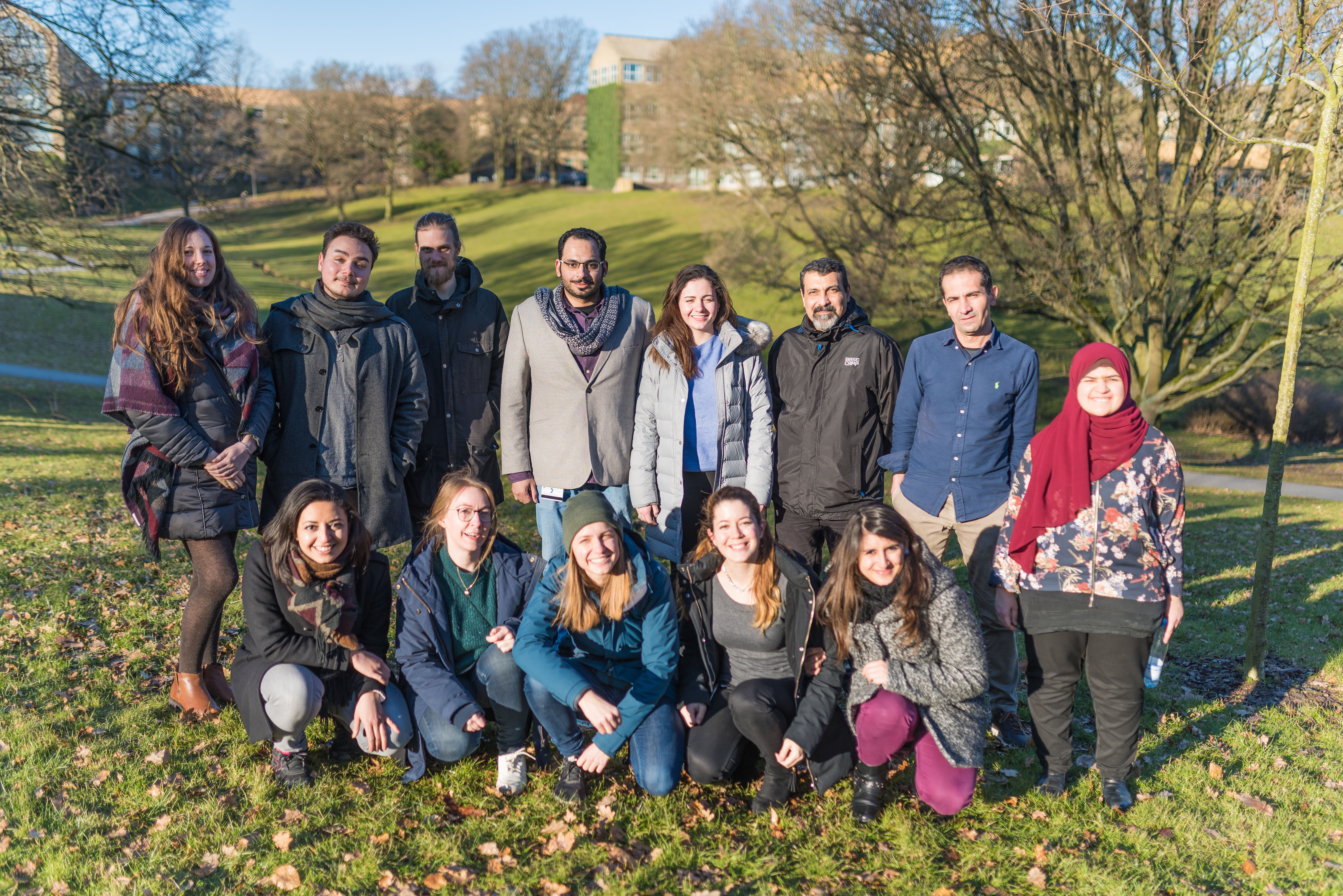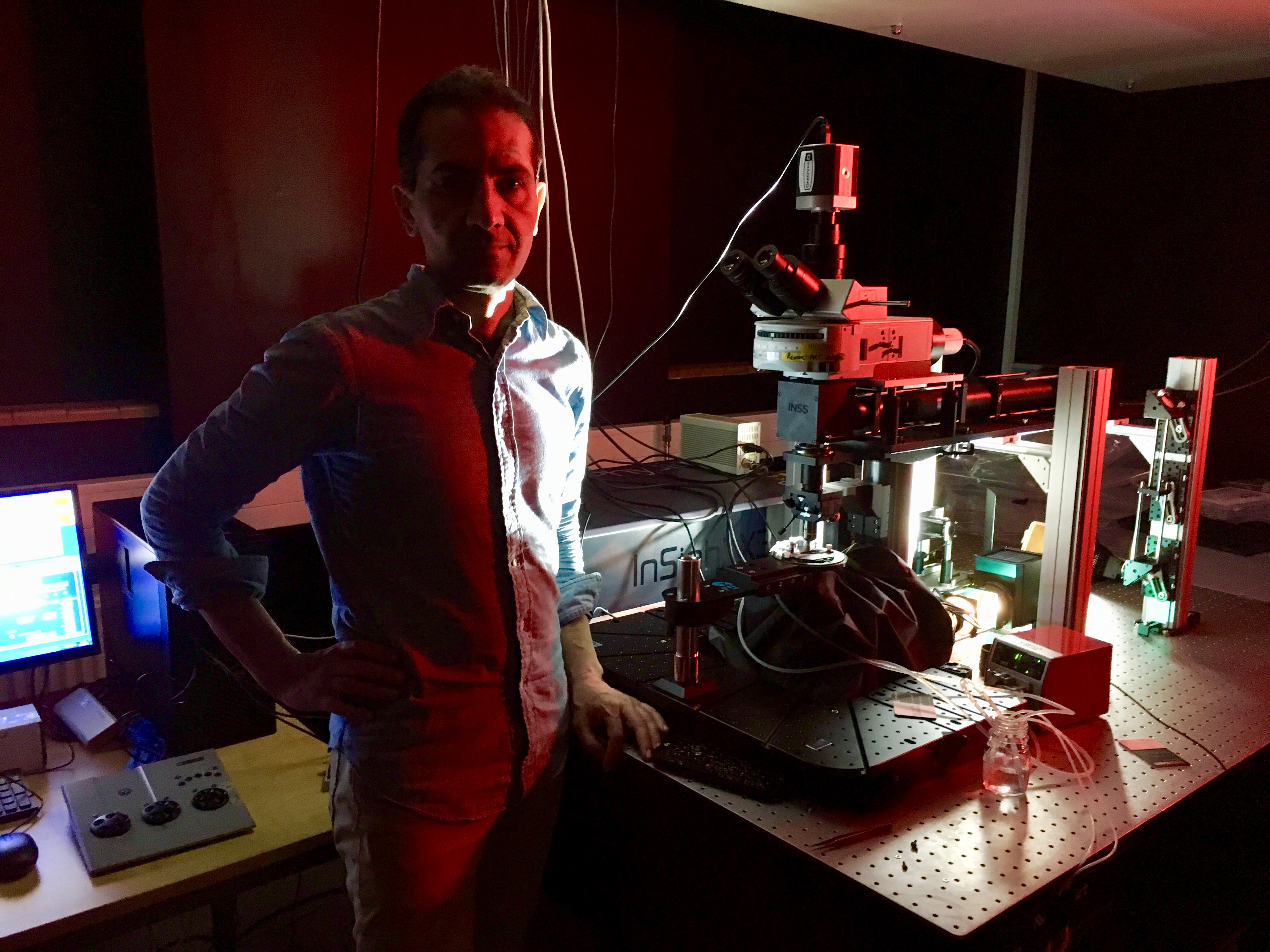Behind the Scenes: Dr Sadegh Nabavi, Group Leader at DANDRITE
Nabavi’s group focuses on memory formation and consolidation at the synaptic and circuit levels. Recently, Dr. Sadegh Nabavi had his group leader position extended for a further four years. In our latest Behind the Scenes article, Dr Nabavi discusses his research and his curiosity and passion for neuroscience.


Can you tell me about your field of interest and research?
Dr Nabavi comments: “We are interested in the mechanisms that underlie the formation of a memory. In this context, learning and memory formations are the same thing. For example; if we learn to play a new instrument, if we learn a new language or if we create a memory about a certain event, at the subcellular level, the mechanisms are probably very similar. We mainly study associative memory which means the ability to associate two events, i.e. you associate a song with a friend, so the next time you hear that song, it reminds of your friend. So, the conception is, what underlies formation of an associative memory at the cellular and circuit level”.
Can you highlight the discoveries that have led up to your current work/research?
In brief, the conceptual framework in part was laid down by Donald O. Hebb, a Canadian psychologist, back in 1949 when he proposed a model on how neural cells could form associations (neural networks). Then, in the early 1970s Timothy Bliss and Terje Lømo worked on stimulating certain pathways in the brain (the hippocampus) with a specific protocol and observed an increased efficiency in neural response that lasted for hours. The phenomenon known as long-term potentiation (LTP) caught the interest as a possible mechanism for memory formation. In the 1980s, the Brain Prize winners Graham Collingridge and Richard Morris showed the connection between the N-methyl-D-aspartate (NMDA) receptor and synaptic plasticity and memory. In the late 1980s and 1990s Roger A. Nicoll (University of California, San Francisco, UCSF), Robert Malenka (Stanord), Roberto Malinow (University of California, San Diego, UCSD), among others, investigated the cellular and subcellular mechanisms and the proteins involved in the formation of LTP.
A system that can go only through potentiation is unstable, consequently the question of having a mechanism to counterbalance LTP was also investigated by many labs such as Mark Bear (MIT) and Robert Malenka. This led to the discovery of long-term depression (LTD), the second from of synaptic plasticity. In 1998, Charles Stevens (Salk institute) wrote an article in Neuron and posed the question if LTP is the mechanism of learning? He put up four criteria; 1. You have to detect LTP when the animal learns, 2. If you block it, the animal should not learn, 3. If you reverse it, the animal should forget what it has learned and 4. If you artificially make naïve synapses potentiate, you should be able to create a memory. The first two criteria were investigated and met by among others Joseph Ledoux (New York university), José Delgado-García (Pablo de Olavide University), and Mark Bear. During my Postdoc at Roberto Malinow’s lab we used a light-based technique called optogenetics to meet all the four criteria. With the use of optogenetics, we were able to artificially strengthen or weaken synaptic connections and thereby able to from or inactivate a memory for example a fear memory. However, we were not able to meet the fourth criterion. As such, still the case for LTP and LTD is not quite settled.
What got you interested in Neuroscience?
Nabavi comments: “I did my PhD in molecular biology in Canada, working with yeast and non-coding RNA and I was very fortunate to have a productive PhD. However, I felt that in biology, neuroscience was the field with major questions to be answered for many years to come. That intrigued me to transition my field of research”.
What challenge are you setting out to address with your research and what translational impact does your research have? Why is it important?
During my postdoc we studied synaptic plasticity in brain slices and in continuation we studied the mechanisms of learning and plasticity in behaving animals. However, I felt that there is a disconnection between what we see at the cellular/circuit level in brain slices and what happens in vivo, which is what we are trying to address. Our studies have potential translational implications. For example, our publication about strengthening or weakening synaptic connections and thereby able to inactivate or reactivate memories attracted a lot of public attention and we received requests from individuals wanting to forget specific incidents they had experienced in their lives! This, of course, belongs to the realm of science fiction. However, at a more realistic level, we have a project led by Andrea Moreno, about studying the process of memory decay. Andrea Moreno received funding from the Lundbeck Foundation and the project consists of two parts; a basic research part and a translational part in forgetting and memory decay.
How do your findings compare with others in the research area? Is there consistency in this research area?
There is this reality about science; sometimes there is consistency in scientific findings and sometimes there is not. During my postdoc, we had a controversial paper which was challenging to get published, since it was going against the dogma. Scientists, who I truly respect, strongly disagreed because our results were inconsistent compared to their results. There are great scientists on both sides of the arguments and therefore, the question is why do we have different results from different labs? These kinds of disagreements happen on the frontier of research. But the great thing about science is its unique emphasis on reproducibility. So as time goes on, the general consensus will emerge. Of course, in many cases there is consistency, for example the paper I referred to earlier, was consistent with previous hypothesis enabling researchers to successfully use the techniques in different brain regions and for different behaviours.
Could you tell me a bit about your group at DANDRITE?
We have group members from many different countries and I think that it is very healthy to work in a highly international environment. Also, I recruit candidates based on their achievements and their expertise. Our Postdoc Noemie Mermet-Joret from France, is skilled in slice electrophysiology. Andrea Moreno from Spain, is another postdoc who has extensive knowledge in in vivo electrophysiology. Our last addition is postdoc Joao Lima from Portugal; he has extensively worked with behaviour in rodents. PhD-student Niels Andersen has a background in neuroscience and has expertise within two-photon imaging and programming. PhD student Nathalie Krauth, from Germany, did a MSc in stem cells, but now well-versed in the brain circuit mapping. PhD-student Mariam Mahmoud Kamel Gameledin from Egypt works with immunohistochemistry and protein chemistry. PhD-student Islam Moustafa Galal Faress has a background in pharmacology but has transitioned to neuroscience. He investigates the heterosynaptic mechanisms of associative-memory consolidation. PhD-student Valentina Khalil has also a background in neuroscience and works with the hippocampus. Also, we have been fortunate with our lab managers/technicians Anne-Katrine Vestergaard, Kathrine Meinecke Christensen, and Randi Melsen all from Denmark, who are instrumental in running the lab smoothly. In our group, we aim high and contribute comprehensively to the research in neuroscience at Aarhus University. In this regard, a dedicated neuroscience program/department in the university would boost further the education as well as recruitment of top students and researchers in the field.
What methodologies/techniques do you use in your lab?
The Nabavi lab passionately focuses on the scientific questions rather than specific methodologies to answer their questions. Nabavi elaborates; “when it comes to methodology, our mindset and mentality is to use whatever it takes to answer the questions. We will use the methods and techniques that are necessary to answer the question and if we need to learn a specific technique – we just learn it”.
The Nabavi lab uses a variety of techniques in their studies, for example slice electrophysiology, in vivo electrophysiology, behavior and classic immunohistochemistry. They also use circuit mapping, which means using different kinds of viruses to identify certain connections between different regions of the brain and also to identify the regions that function together in particular behavior called functional circuit mapping. Also, two-photon imaging (supported by Anders Nykjær/PROMEMO), fiber-photometry, and optogenetics are techniques that we use to investigate the mechanisms of memory formation and systems consolidation. Recently, the Nabavi group started to use Miniscope (funded by Anders Nykjær/PROMEMO). Using the miniscope we can image hundreds of active neurons at the same time for many days. Sadegh comments: “all the techniques we apply in our research complement each other and by combining the variety of techniques we are able to answer our questions”.
Are you collaborating with other researchers at the moment?
Many of my collaborators are from my postdoc time at UCSD, but we are also collaborating with most of the members in DANDRITE. In addition, I collaborate with Dr. Marco Capogna who is affiliated with DANDRITE. Outside Aarhus University, I collaborate with my former PI (Roberto Malinow) at UCSD on a project involving fiber-photometry. We got an award together with John Lin in Australia (the brain initiative award by Lundbeck foundation/NIH) to develop a new technique in optogenetics. On this project, we also work with Joaquin Piriz in Argentina. In our research on proteins and memory (a major aim of the center PROMEMO), we collaborate with John Yates (UCSD), Markus Muttenthaler (Austria), and Itaru Hamachi (Japan).
What are your goals for the second phase as a DANDRITE group leader?
We have a couple of projects that we are working on. In brief, the main goal of our projects is to understand two questions: How associative learning happens in vivo in a naturalistic frame. This is a project we are intensely working in collaboration with Duda Kvitsiani (Group Leader, DANDRITE). The other question we want to investigate is, why some memories last longer than other memories. We got an ERC funding dedicated to this question. Our current project about forgetting will to complement this question. Meanwhile, we have a project dedicated to investigate the circuits underlying innate vs learned behaviour. We think that understanding, at the cellular level, the mechanisms underlying an innate behaviour (i.e. does not need learning), will help us to get a better insight in the cellular mechanisms for learning and plasticity.
Can you share a defining moment in your work as a scientist?
Nabavi comments; “A defining moment for me was when I switched to the field of neuroscience. My postdoc PI (Roberto Malinow) put his faith in me even though I came from a very different background and did not have the expertise at the time. Another memorable moment was, when I for the first time saw that with simple manipulation of synaptic strength, I could change the behaviour in an animal so much, as if I turned a light on or off. This was something that many years of experimental and theoretical work predicated. It made me better appreciate the argument that science (and its methods) is the sole source for getting us to the objective truth”.
If you could give one piece of advice to upcoming scientists, what would it be?
Nabavi comments; “I think it is important to state, that as a scientist, you should be able to cope with setbacks, you need to be resilient, sharp, passionate and a hard worker. My advice for those who want to have a scientific career in academia, is the same hard-boiled but honest advice that Gerald Rubin (the director of Janelia) gives to his students and postdocs: “Can you imagine yourself doing anything else that you would find equally satisfying, and if the answer is yes, you should do that other thing. Because it will be easier, it will pay better, they will have more job security. The only reason anyone should go into science is that they can’t imagine themselves doing anything else.”
For more information about the Nabavi group, visit http://dandrite.au.dk/people/group-leaders/nabavi-group/